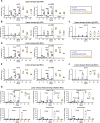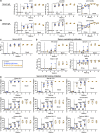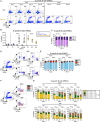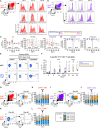Mucosal prime-boost immunization with live murine pneumonia virus-vectored SARS-CoV-2 vaccine is protective in macaques
- PMID: 38670948
- PMCID: PMC11053155
- DOI: 10.1038/s41467-024-47784-6
Mucosal prime-boost immunization with live murine pneumonia virus-vectored SARS-CoV-2 vaccine is protective in macaques
Abstract
Immunization via the respiratory route is predicted to increase the effectiveness of a SARS-CoV-2 vaccine. Here, we evaluate the immunogenicity and protective efficacy of one or two doses of a live-attenuated murine pneumonia virus vector expressing SARS-CoV-2 prefusion-stabilized spike protein (MPV/S-2P), delivered intranasally/intratracheally to male rhesus macaques. A single dose of MPV/S-2P is highly immunogenic, and a second dose increases the magnitude and breadth of the mucosal and systemic anti-S antibody responses and increases levels of dimeric anti-S IgA in the airways. MPV/S-2P also induces S-specific CD4+ and CD8+ T-cells in the airways that differentiate into large populations of tissue-resident memory cells within a month after the boost. One dose induces substantial protection against SARS-CoV-2 challenge, and two doses of MPV/S-2P are fully protective against SARS-CoV-2 challenge virus replication in the airways. A prime/boost immunization with a mucosally-administered live-attenuated MPV vector could thus be highly effective in preventing SARS-CoV-2 infection and replication.
© 2024. This is a U.S. Government work and not under copyright protection in the US; foreign copyright protection may apply.
Conflict of interest statement
J.A.K., C.L., S.M., C.L.N. and U.J.B. are inventors on the provisional patent application number 63/502,829 entitled “Recombinant murine pneumonia virus expressing severe acute respiratory syndrome coronavirus 2 (SARS-COV-2) spike protein” filed by the United States, Department of Health and Human Services. The remaining authors declare no competing interests.
Figures







Update of
-
Mucosal prime-boost immunization with live murine pneumonia virus-vectored SARS-CoV-2 vaccine is protective in macaques.Res Sq [Preprint]. 2023 Sep 13:rs.3.rs-3278289. doi: 10.21203/rs.3.rs-3278289/v1. Res Sq. 2023. Update in: Nat Commun. 2024 Apr 26;15(1):3553. doi: 10.1038/s41467-024-47784-6. PMID: 37790295 Free PMC article. Updated. Preprint.
References
-
- WHO. COVID-19 epidemiological update. in Emergency Situational Updates 164 edn (World Health Organization, 2024).
Publication types
MeSH terms
Substances
Grants and funding
LinkOut - more resources
Full Text Sources
Other Literature Sources
Medical
Research Materials
Miscellaneous

